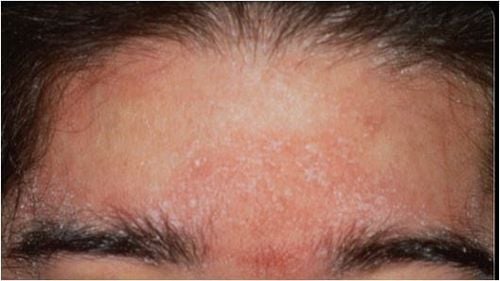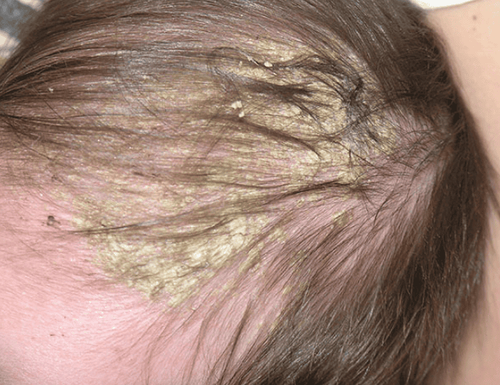This is an automatically translated article.
The article was professionally consulted by Specialist Doctor I Tran Van Sang - Dermatologist - Department of Medical Examination & Internal Medicine - Vinmec Danang International General Hospital. The doctor has 18 years of experience in the field of Dermatology.Seborrheic dermatitis is a disease with a persistent course, difficult to treat and often recurs. The disease usually progresses seriously in the autumn - winter. Currently, it is estimated that 2-5% of the world's population suffers from this disease.
1. What is seborrheic dermatitis?
Seborrheic dermatitis is also known as seborrheic dermatitis, greasy eczema. This is a common chronic inflammatory skin disease with a characteristic picture of a scaly erythematous patch in the seborrheic area (wrinkles of the nose, cheeks, eyebrows, parotid, front chest, scalp). More specifically, seborrheic dermatitis causes the skin to dry out and flake off, causing the skin to become red and scaly. It usually affects oily areas of the skin, but it can also appear in areas where the skin is thick and dry.In children, this disease is named in folklore as "buffalo dung". This disease is not contagious, does not affect health much, but can affect appearance and make patients feel uncomfortable. Seborrheic dermatitis usually persists for a long time and requires repeated treatment.
2. Causes of seborrheic dermatitis

Currently, the exact cause of seborrheic dermatitis has not been determined. However, it can be explained that the phenomenon of increased sebum or sebum on the skin is the cause of the skin inflammation. In addition, fungi or bacteria such as: Malassezia ovale, P. Acne bacteria play an important role in the pathogenesis of the scalp.
The disease is related to a number of factors such as:
Due to oily skin, a lot of oil: There is a relationship between seborrheic dermatitis and the amount of sebum, which is evident in adolescents and young people (due to the increased activity of the sebaceous glands), the location of the lesion distribution is the sebaceous area. Hormones also influence the development of the disease: Seborrheic dermatitis is more common in men than in women, which indicates an influence of androgens on the sebaceous follicle unit. Genetic factors are also the cause of the disease: If there is a family member with seborrheic dermatitis or psoriasis, the probability that the next generation will have this disease is very high... Factors promoting seborrheic dermatitis :
Physical or mental stress, Parkinson's disease, mental illness Hormonal changes, improper nutrition, alcohol consumption, body fatigue, obesity, immunodeficiency such as HIV infection are factors that increase the risk of disease.
3. Recognizing symptoms
Seborrheic dermatitis is a disease that occurs gradually, not suddenly. Usually patients do not feel itchy but there are some cases of itching, mild or moderate discomfort. When the weather is hot and sweaty, the itching may increase.Diseased skin areas are usually red-orange, covered with gray-white scales, dry or greasy, sometimes appear scaly papules with clear margins, often found on the chest and back. The chest and back can also show coin-shaped, ring-shaped lesions... that make the patient think they have fungal skin diseases. There are also red patches between the ears, cracks, and red lesions in the ear canal, scaly skin, making it easy to mistake it for a fungal infection of the ear canal.
In hairy areas such as: head, eyebrows, eyelashes, beard... often see white sticky skin scales. On the face, there are lesions such as: butterfly-shaped cheeks, forehead edge, between the nose, red skin between the eyebrows, scaly skin. Large folds such as armpits, groin, interstitial buttocks, folds under the breast, navel ... often have clear boundaries, dark red, sudden skin, cracks and can secrete fluid when the disease is severe or rubbed a lot.
The disease is common in areas of the skin with many active sebaceous glands, especially the face, head, chest, back and large folds. There are many flakes on the head that we call scalp dandruff.

4. Diagnosis of seborrheic dermatitis
Seborrheic dermatitis is fairly easy to diagnose, but in some cases it can be mistaken for psoriasis or the onset of psoriasis. The disease can also be confused with superficial candidiasis, interstitial candidiasis, subacute lupus erythematosus and some other skin diseases. One thing of concern is that the patient sees that the skin is red, scaly and takes a long time to heal, so they think they have ringworm, don't trust the treatment and go to many places for treatment according to the advice, the result is too much application. many drugs and diseases become difficult to cure.Please dial HOTLINE for more information or register for an appointment HERE. Download MyVinmec app to make appointments faster and to manage your bookings easily.














